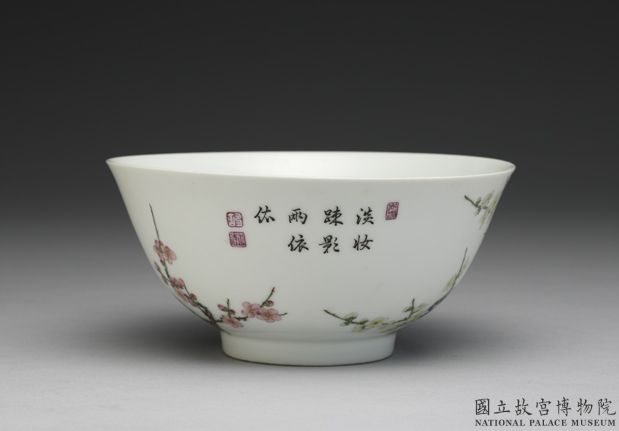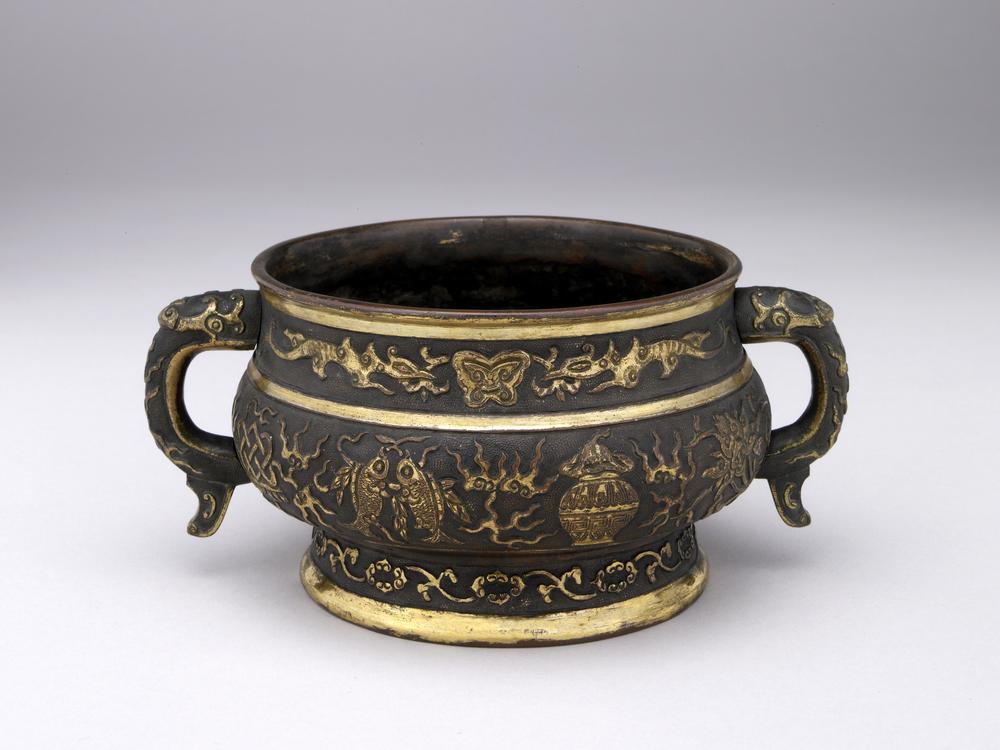Period:Ming dynasty Production date:1488-1505
Materials:porcelain
Technique:glazed, underglazed,
Subjects:eight treasures of buddhism canopy
Dimensions:Diameter: 13.60 centimetres Height: 6.70 centimetres
Description:
Porcelain bowl with underglaze blue decoration. This restored ‘min yao’ bowl has rounded sides, an everted rim and a high tapering foot. It is painted in an uneven blue cobalt beneath the glaze. Inside, in the flat centre of the bowl, surrounded by a double ring, is a large flower head from which radiates a circle of leaves. Outside, five roundels contain some of the Eight Treasures of Buddhism: two conch shells, a furled parasol, a canopy and an endless knot. Double lines are unevenly painted around the foot, below the roundels and on the inner and outer rim.
IMG
![图片[1]-bowl BM-1971-0519.1-China Archive](https://chinaarchive.net/Ming dynasty/Ceramics/mid_00253208_001.jpg)
Comments:Harrison-Hall 2001:Dating this type of popular ware is difficult as the same designs were used over a long period. A similar bowl with a variation of these auspicious symbols of Buddhism is in the Jingdezhen Ceramics Institute dated to the Chenghua era. The designs on the British Museum bowl may be regarded as a simplified version of this. Certainly it is reminiscent of Chenghua ‘doucai’ motifs of lotus and a leaf forming a roundel. It is also related to similar motifs found on an unmarked Chenghua altar vase in the private collection of the Ma family. A bowl with similar roundels and with a Chenghua mark was excavated at Zhushan. Yet the uneven quality of the cobalt ranging from pale blue through bright blue to black is typical of the Hongzhi era, hence its dating to the Chenghua to Hongzhi eras.
Materials:porcelain
Technique:glazed, underglazed,
Subjects:eight treasures of buddhism canopy
Dimensions:Diameter: 13.60 centimetres Height: 6.70 centimetres
Description:
Porcelain bowl with underglaze blue decoration. This restored ‘min yao’ bowl has rounded sides, an everted rim and a high tapering foot. It is painted in an uneven blue cobalt beneath the glaze. Inside, in the flat centre of the bowl, surrounded by a double ring, is a large flower head from which radiates a circle of leaves. Outside, five roundels contain some of the Eight Treasures of Buddhism: two conch shells, a furled parasol, a canopy and an endless knot. Double lines are unevenly painted around the foot, below the roundels and on the inner and outer rim.
IMG
![图片[1]-bowl BM-1971-0519.1-China Archive](https://chinaarchive.net/Ming dynasty/Ceramics/mid_00253208_001.jpg)
Comments:Harrison-Hall 2001:Dating this type of popular ware is difficult as the same designs were used over a long period. A similar bowl with a variation of these auspicious symbols of Buddhism is in the Jingdezhen Ceramics Institute dated to the Chenghua era. The designs on the British Museum bowl may be regarded as a simplified version of this. Certainly it is reminiscent of Chenghua ‘doucai’ motifs of lotus and a leaf forming a roundel. It is also related to similar motifs found on an unmarked Chenghua altar vase in the private collection of the Ma family. A bowl with similar roundels and with a Chenghua mark was excavated at Zhushan. Yet the uneven quality of the cobalt ranging from pale blue through bright blue to black is typical of the Hongzhi era, hence its dating to the Chenghua to Hongzhi eras.
© Copyright
The copyright of the article belongs to the author, please keep the original link for reprinting.
THE END





